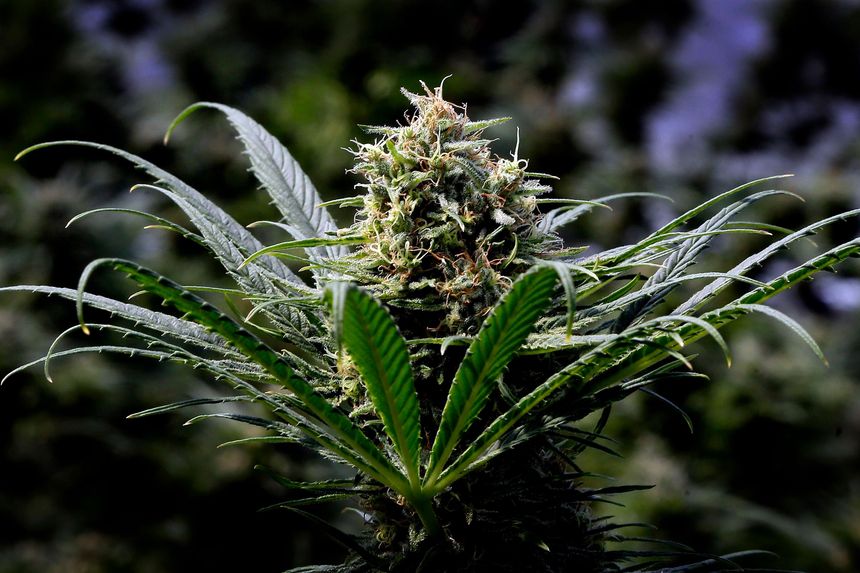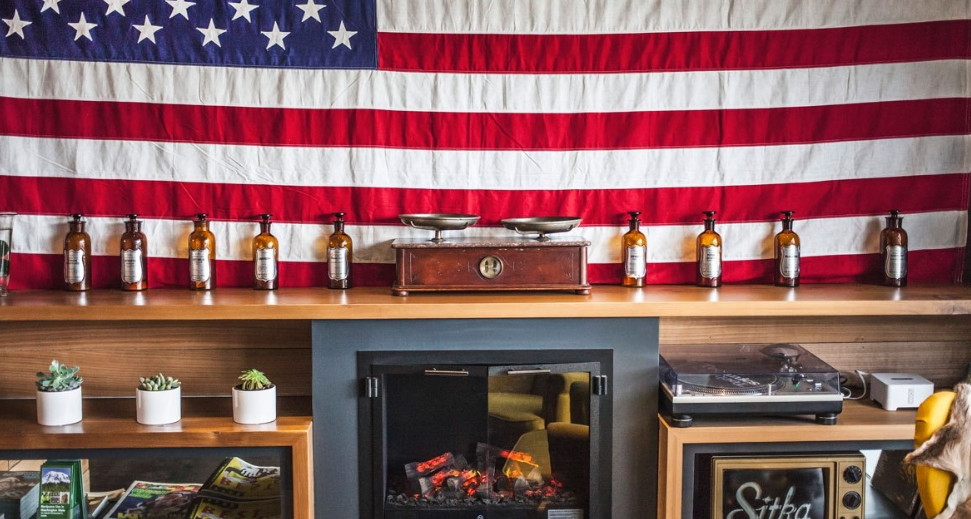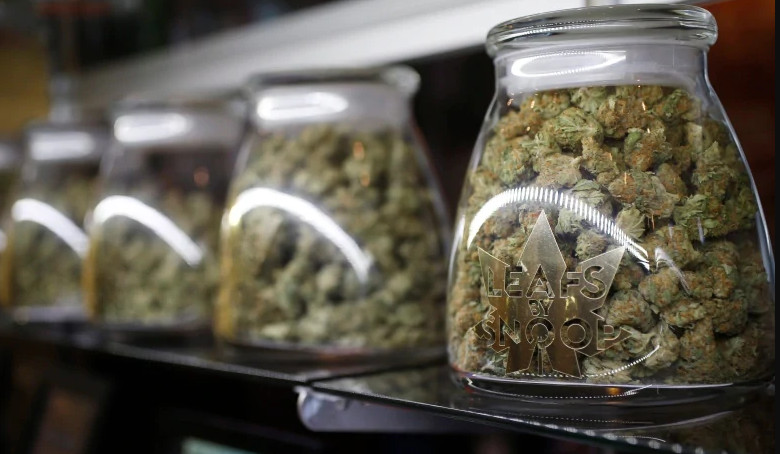John Plummer, founder and co-owner of Bull Run Craft Cannabis in Boring, Oregon, got his first hint that the state was careening toward a marijuana glut two years ago.
In early 2016, his company received one of Oregon’s first few licenses to grow recreational cannabis. In June of that year, Plummer and one of his employees stood third in line to pay at Camps True Value Hardware, in nearby Gresham. They were buying lumber to fence a temporary outdoor operation that would ensure a quick harvest while they set up their more labor-intensive indoor facility.
The cashier asked the couple at the front of the line what they were building.
“Recreational marijuana is legal now, so we’re going to start farming it,” Plummer overheard the couple say.
The next people in line, an older couple, chimed in that they, too, were building a space to grow recreational cannabis. Plummer and his employee glanced at each other, eyebrows raised. Every person in line at the lumber store was farming cannabis.
Two years later, Plummer laughs as he recounts the absurdity of the scene. “I mean, what are the chances?” Plummer says.
Pretty good, it turns out. Oregon now has 1,012 licensed growers, with another 956 in the process of obtaining licenses. All those growers in a state with just four million residents has resulted in a mountain of marijuana. Nearly one million pounds of usable flower remains unsold – about three times what consumers purchased in all of 2017. Prices of the recreational drug have plummeted, with dispensaries selling pre-rolled joints for $1, less than the price of a cigarette.
That leaves growers to face tough decisions. Some are getting out of the business altogether. Others are struggling to stay afloat. If the product can’t be sold before it goes bad, the legal method of disposal is to burn or compost it. For growers with no other options, that means churning all their hard work and money back into the soil or igniting it into an expensive, fragrant bonfire. Officials say desperate growers are increasingly turning to the black market.
When Oregon launched its recreational cannabis program in 2016, the first growers’ licenses were issued just six months before retail dispensaries opened shop. Plummer and two of his business partners, growers Steve Bailey and “EZ Mike” Scarbrough, were waiting at a computer the morning that Oregon put its application online. Then it was a mad dash to get their product on shelves in time for shops to open.
That fall, Oregon growers harvested about one million pounds of wet-weight cannabis, according to the state tracking system. Processing shrunk that down – drying weed cuts it to about a quarter of its original weight – and consumers snatched it up. Demand was high and prices were astronomical.
Robin Cordell, co-founder and owner of Oregon Girl Gardens LLC, was a little slower to set up her farm. Cordell has a degree in horticulture and opened the business with her brother and sister-in-law on a swath of overgrown land behind their parents’ house. She had no trouble selling her first few harvests in early 2017.
“One distributor said to me, ‘We’ll take whatever you have and we’ll pay whatever you want for it,’” she says. “You could make a very good living at $2,000 a pound.”
But those prices didn’t last long, and expenses kept mounting. Cordell says she had trouble keeping up with regulations, not only from the state but the county.
The two standard greenhouse fans she bought, for example, were considered too loud given the building’s proximity to her property line. To stay in compliance, she had to replace the fans with five smaller, indoor-rated fans. She says that switch cost her an extra $2,000.
Meanwhile, more growers were coming on line and adding to the state’s supply.
David Fowler became interested in cannabis in 2014, after it helped him overcome a chronic sleep problem. An empty nester with ample savings, the civil engineer-turned-financial advisor longed to start his own business on the side. Fowler decided to start small.
He purchased property that he felt confident he could turn around and sell, regardless of the state of the cannabis industry. The property had an old farmhouse on it, which Fowler converted into an indoor grow facility, doing most of the construction himself.
“We started taking our product around, just to get an idea of what dispensaries would think about it,” Fowler says. “This was in July 2016. Everybody back then was in desperate need of indoor (high-quality) flower.”
But it was January 2017 by the time Fowler’s operation was licensed. The first harvest was in May 2017, when prices were still high, around $2,300 to $2,500 per pound. That was more than he had counted on. In his business plan, Fowler had penciled in a per-pound price of $1,400, to play it safe.
“You can’t get any loans in this business, and I knew that from the time we started, we would have zero cash flow for the first five or six months, so I made operations really cheap,” he says.
After a few months, prices slipped to $1,900 per pound. Then, in October 2017, Oregon growers harvested 2.5 million pounds of wet-weight cannabis – more than twice the previous year’s crop. By then, there were hundreds more indoor grow operations, too, which harvest regularly throughout the year.
Prices dropped to $1,200 per pound, and Fowler grew frustrated with dispensary managers.

Credit: www.rollingstone.com
“You would start having this relationship where they would say, ‘We’ll take two pounds this week and then in two weeks, bring me another pound.’ Eight times out of ten when you called to say ‘I’ve got your next order ready,’ they’d say, ‘Give me a couple more days.’ And then when you called back, they’d say, ‘Oh, someone came in yesterday and we bought all their product,’” he says.
When dispensaries did buy a pound or two, they didn’t pay much. Fowler was getting offers for $800 per pound.
He laid off three of his four employees, so only he and the master grower remained. Farming is always hard work, but cannabis involves a particularly labor-intensive routine after harvest, to dry the flower and trim it without compromising quality. Fowler and his grower were working around the clock. And Fowler still had a day job. Even with no employees, the operation was barely breaking even. About a year into the venture, Fowler put his farm on the market. He sold it this month for a little more than he paid for the land. “It was a good time to get out,” he says.
Fowler recently dropped his last 40 pounds of cannabis off at a processor who turned it into extract and split the sale price with him. When he looks back on his experience, he mostly feels relief that it’s over. He thinks it will take years for the market to stabilize.
“The only way to really enjoy it is to have 10 employees,” he says. “I know what it takes to get to that level – you have to be producing 800 pounds a year and bringing in $1 million. We were at a point where we could do 300 to 350 pounds a year.”
Fowler estimates that he lost between $50,000 and $60,000 in his venture, and says he feels lucky about that figure. “People in the business,” he says, “hear what I lost and say, ‘That’s it?’”
In January, with prices plummeting due to oversupply, Cordell’s relatives decided to pull out of their company, leaving her to run the operation herself. She says she is not currently speaking with her brother and sister-in-law, and compares the fallout to going through a divorce.
She plans to grow medicinal cannabis this year and eventually switch to hemp. She also intends to grow food and medicinal herbs, and to start teaching classes on gardening and making therapeutic food and body products. “I’m just looking for things that not everyone is doing,” she says. “This is the life a lot of people want to live.”
Plummer, on the other hand, is sticking it out. Bull Run Craft Cannabis has marketed its organic farming practices and its carefully curated strains. “We’re kind of the ‘soccer mom’ brand right now,” he says, “and we’re really proud of that.”
Plummer has decades of experience building small businesses in Portland that overcome stark odds. He owns a popular bar and music venue, and he owned a shoe store that thrived downtown for more than 20 years despite the rise of big box stores and online behemoths.
Besides, Plummer and his partners are not strangers to risk. Back in 1998, “EZ Mike” Scarbrough served 90 days in jail for growing five marijuana plants under a light in his closet. “I was really lucky to be in a tolerant state,” he says of the experience.
Scarbrough had moved a couple of years earlier from Utah, where the same activity could have resulted in a seven-year sentence. His record was expunged in 2015, and 10 years after he was released from jail, he applied for and received a license to grow medical marijuana in Oregon.
But today, Scarbrough’s “tolerant state” has caused new headaches. Unlike Washington and Colorado, which control the number of cannabis licensees and who can invest in them, Oregon has taken a free-market approach, with no caps on licenses issued or out-of-state investment. “The marketplace is a closed system,” Plummer says. “We’re producing, producing, producing, which would be great if it were like our craft beer industry or our wine industry, which sells all over the world.”
Instead, it remains federally illegal to transport cannabis across state lines. Last month, Oregon’s U.S. Attorney, Billy Williams, issued a memo challenging the state to do something about its oversupply issue, and vowing to crack down on the illegal black market. In a press conference, he said large amounts of Oregon-grown marijuana have been seized in 30 states. Earlier this year, Oregon lawmakers earmarked an additional $1.5 million in law enforcement, to crack down on the illegal cannabis market.
“Everybody in the industry knows someone who is doing something shady if not outright illegal,” Plummer tells us. “There are only three choices: sell it legally, dispose of it legally or do something illegal.”
Cordell says she wishes there were a legal avenue for donating unsold product to low-income patients, for example. “It would take some crappy options off people’s plates,” she says.

Credit: www.rollingstone.com
Plummer says once-friendly relationships between growers have turned sour and suspicious. He says he’s heard of growers reporting violations to the state that they spotted on other growers’ social media feeds.
Oregon uses a seed-to-sale tracking system to log recreational cannabis as it’s grown, processed and sold. State code instructs growers to dispose of any cannabis they can’t sell by composting it, burning it or dumping it in a landfill. Any product that can’t be sold has to be marked for disposal in the online tracking system and then stored on the premises for at least three days before it’s discarded, so inspectors can stop by to verify.
As cannabis has piled up, disposal of usable marijuana has increased. In March 2017, growers destroyed about 3,367 pounds of usable marijuana, according to the state tracking system. In March of 2018, growers destroyed 13,976 pounds.
The agency that handles licensing and compliance recently stopped accepting new applications, from June 15 until at least January 2019, but a spokesman says that decision had nothing to do with concerns about illegal activity. Mark Pettinger, of the Oregon Liquor Control Commission, says it was based on a simple backlog of applications. Despite turmoil in the market, people are still lined up to go into the cannabis business.
“We foresee it taking six to nine months for us to get through the work we already have,” Pettinger says of the licensing backlog.
He adds that only the state legislature – which next convenes in February 2019 – has the power to cap licenses. “We can’t do it unilaterally,” he says of his agency.
Growers say they expect it will take several years for the oversupply to work itself out. Plummer remains optimistic that the federal government will eventually legalize cannabis. If that happens, he thinks whatever Oregon producers remain in business will be poised for success. Oregon growers are engaged in the agricultural equivalent of an arms race to produce cannabis that stands out from the competition.
“One positive of all of this is that Oregon is producing the most scrutinized weed that the world has ever seen,” Scarbrough says. “We’ll take the Pepsi Challenge with anyone right now.”
Tris Reisfar is co-owner of Blazing Trails, a cannabis tour company in Bend, Oregon. Many of his tours turn into de facto consulting sessions. “Lots of people who come visit are dreaming of getting into the industry,” he says.
Reisfar is honest with them. He tells them that prices have plummeted, that growers are desperate. He tells them about growers who lost their life savings, even their homes. None of it dulls the twinkle in peoples’ eyes. “They hear me, but they don’t really hear me,” he says.
Plummer compares the current market to the Gold Rush, when people were dying and losing everything they owned, yet hordes more kept flooding into California to pan for gold. “There’s this romantic idea, it doesn’t matter that it’s not reality,” Plummer says.
Even Plummer can’t really help himself. He still sees opportunities.
“My mom’s a senior citizen and she won’t stop talking to her friends about her pot cream that helps her arthritis so much. I keep expecting to see the farm that sort of brands itself as the senior citizen brand,” he says. “That would be a really smart move.”
Credit: www.rollingstone.com



